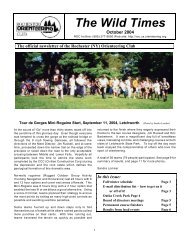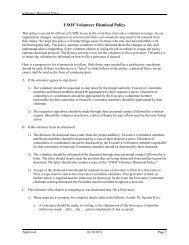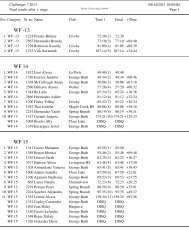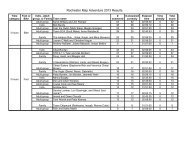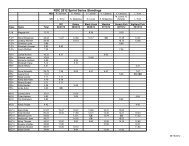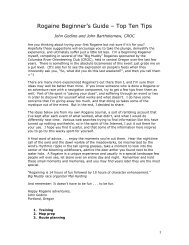A Rules for Foot Orienteering Events - Orienteering USA
A Rules for Foot Orienteering Events - Orienteering USA
A Rules for Foot Orienteering Events - Orienteering USA
You also want an ePaper? Increase the reach of your titles
YUMPU automatically turns print PDFs into web optimized ePapers that Google loves.
A.22.3.2 U.S. Championship categories/courses shall be as follows:<br />
v) Lowest point teams shall have no more than two segments of Orange<br />
(moderate) level difficulty, the remaining segments being equivalent to<br />
Brown through Red difficulty.<br />
w) Medium (to High) point teams shall have no more than one segment of<br />
Yellow (easy) level difficulty, no more than one segment of Orange<br />
(moderate) level, any other segment equivalent to Brown through Red<br />
difficulty.<br />
x) Optional - High point teams shall have no more than two segments of<br />
Yellow (easy) level difficulty, no more than two segments of Orange<br />
(moderate) level, any other segment equivalent to Brown through Red<br />
difficulty.<br />
A.22.3.3 ELIGIBILITY: U.S. Relay <strong>Orienteering</strong> Championship teams represent<br />
chartered Clubs. All team members must compete <strong>for</strong> their primary club and<br />
meet the individual U.S. Champion eligibility requirements .<br />
A.22.4 Technical <strong>Rules</strong><br />
A.22.4.1 Relays may be made up of legs of Sprint, Middle, or Long Format. Map and<br />
Course Design considerations <strong>for</strong> each leg will follow the applicable rules.<br />
A.22.4.2 TERRAIN SELECTION: Choosing terrain with an arena <strong>for</strong> the start, finish,<br />
exchange, and spectating is extremely important <strong>for</strong> the relay event. The<br />
terrain should provide a fair test of orienteering <strong>for</strong> all skill levels, and shall not<br />
be so extreme physically or technically, as to exaggerate team separation.<br />
Varying visibility conditions are desirable.<br />
A.22.4.3 Relays shall be made up of at least two segments.<br />
A.22.4.4 Each relay team competing in the same category shall run the same<br />
combination of legs, whether in the same order or in a different order shall be<br />
at the discretion of the event organizers.<br />
A.22.4.5 COURSE PLANNING: Relay courses should provide spectating opportunities,<br />
most typically at least one loop through the spectator area, in addition to the<br />
final approach to the Finish. The courses shall test all skills as the terrain<br />
allows, with a special attention to route choice and varied visibility to increase<br />
the competitive excitement. The course design may incorporate a <strong>for</strong>king<br />
system, provided that all teams ultimately run the same legs, and the last<br />
section of the last leg, roughly 1.0km, must be common <strong>for</strong> all teams.<br />
A.22.5 Scoring and Timing





